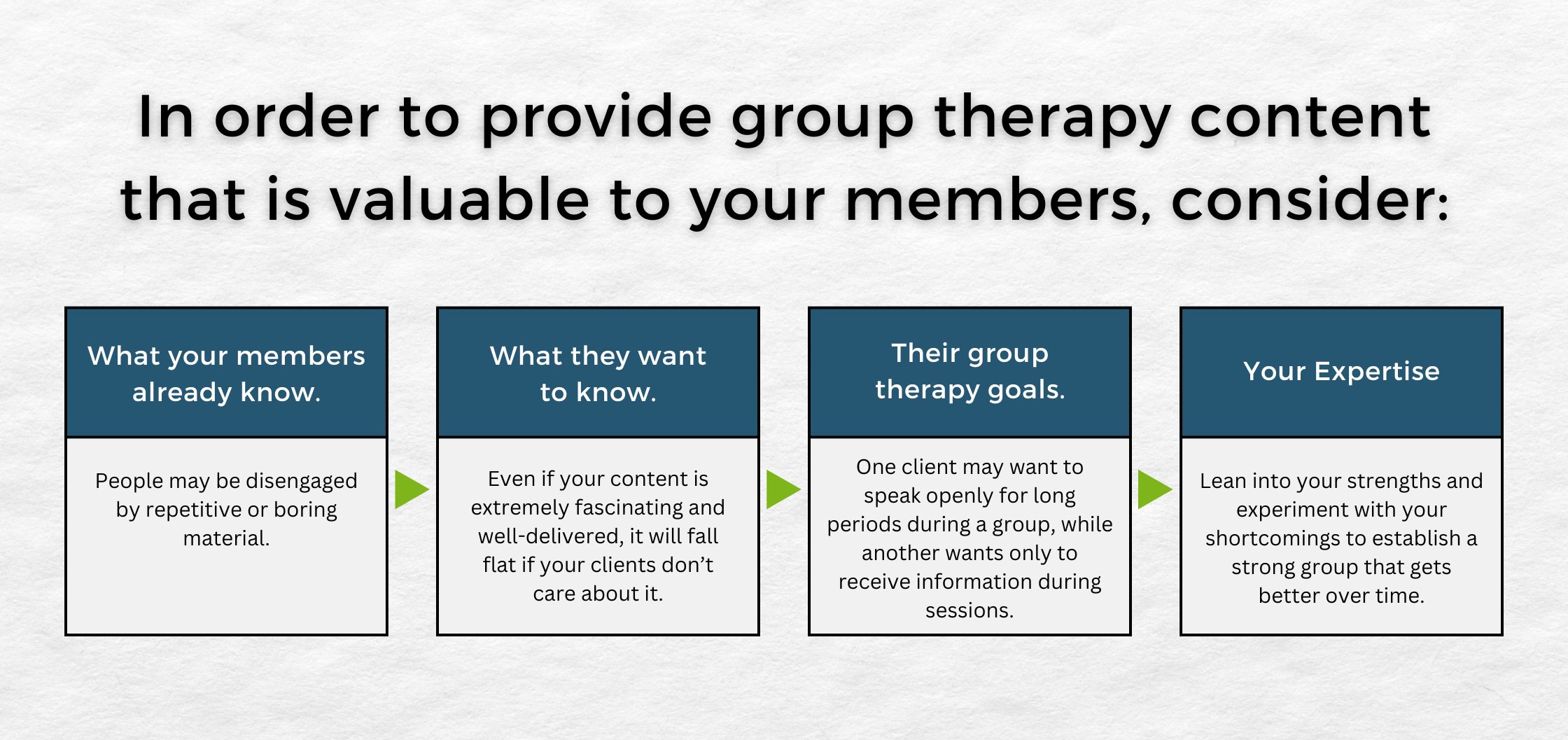
How to Run Group Therapy Sessions Successfully
Having a plan for a therapy group is wonderful, but until you put your plan into motion and learn how to run group therapy sessions, the success is theoretical and the risks seem daunting. From session 1 to session 1001, a great therapist focuses on ways to boost benefits and shrink the risks. As a group therapist yourself, this must become your mission.
Any therapist can have an amazing session, just as any therapist can have an awful, forgettable session, but those who do well to plan, prepare, and adjust will find themselves with group therapy sessions that consistently create progress for the group members. Read on to learn how. (1, 2)
Free Download: Group Therapy Starter Kit

Clarify Your Role in Group Therapy Sessions
For yourself and for your group members, you’ll need to clarify your role in the group therapy sessions from the outset. What kind of therapist are you going to be, and what kind of therapist would they like you to be?
A very active, vocal, and directive therapist will bring a much different energy to the room than one who is intentionally passive, quiet, and allows the group to proceed with little involvement. To be clear, though, both types of therapists are wonderful supports, depending on the group, its members, and its goals.
Leading a group affords you the opportunity to “try on different hats” with your therapeutic style. Of course, you want to be an authentic therapist, but exaggerating or minimizing certain characteristics can produce different versions of you that benefit the group.
Build Structure and Routine into Your Group Therapy Sessions
Group therapy sessions should generally follow the structure of the ones it follows and precedes. This routine creates habits that get group members comfortable, relaxed, and more willing to participate in whatever group has to offer.
Your structure can include whatever makes sense, feels right, and fits into the time allotment of the group with the predictability adding safety and security to group members Generally, group therapy sessions should include a brief “warm-up” period that allows clients to acclimate to the expectations of the session.
Similarly, the end of the session should involve a “cooldown” period where clients can shift their focus away from therapy-related content. Here, they can work to reduce their emotional output and prepare to reenter the outside world. Leaving a client highly emotional at the end of a group session is problematic, but sometimes unavoidable.
The middle of your group therapy sessions should comprise the largest quantity of time. This is where the therapy happens, whether that involves processing feelings, discussing mental health-related content, or learning about a new coping skill.

Create Engaging Content for Group Therapy Sessions
Perhaps the best way to boost the success of group therapy sessions is by creating and sharing engaging content with your members. Simply put, if you make the group worth coming to, your members will attend consistently and their symptoms will improve.
The old therapy idiom of “Don’t work harder than your clients” is not always true, especially in the context of group therapy. A therapist has to work really hard in the planning, preparation, and execution of the early group therapy sessions as these meetings will set the tone for the next ones.
In order to provide group therapy content that is valuable to your members, consider:
- What your members already know. People may be disengaged by repetitive or boring material. If your client already knows a lot about your material, they may not be interested.
- What they want to know. Along these lines, figure out what your clients want to know. Even if your content is extremely fascinating and well-delivered, it will fall flat if your clients don’t care about it.
- Their group therapy goals. One client may want to speak openly for long periods during a group, while another wants only to receive information during sessions. These two clients will not experience the same level of engagement throughout the group sessions.
- Your expertise. It wouldn’t be the best idea to lecture your group members for 60 minutes if you struggle with presentation just as allowing your clients to freely process their traumas would be tricky if you struggle to manage intense content. Lean into your strengths and experiment with your shortcomings to establish a strong group that gets better over time.
Explore Process Therapy Groups and Experiential Sessions
Process therapy groups are ones that, on the surface, seem to have nothing to do with the topic. Rather than overtly targeting the themes or symptoms involved in the group, process sessions indirectly address the needs of the members.
For example, having a group session that focuses on the shared experience of completing a jigsaw puzzle may seem like a waste of client time and therapist skill, but if one of your group therapy goals is to improve communication skills, giving the members a task that will be aided or hindered by teamwork and listening is a wonderful idea.
Therapists may want to use process therapy groups sparingly, though, as they can distract from the overall vision of the group. Keep members grounded to the topic by discussing their experience after the exercise or during the next group therapy session.

Solicit Feedback with a Group Therapy Evaluation Form
To ensure clients are getting the most out of group therapy sessions, utilize a group therapy evaluation form. These allow members to discuss what they appreciate or don’t appreciate about the sessions. Ideally, clients will feel comfortable enough bringing this content to the group, but they may prefer the option to state their opinion with anonymity on a group therapy feedback form.
Resolving or Removing Risks During Group Therapy Sessions
Adding positives to the group experience is essential, but sometimes the only way to truly optimize a group is by targeting risks. By resolving or removing risks from their group therapy sessions, therapists can create a healthy, supportive environment for all.
Some types of risk that you may need to manage as a group leader include:(3)
- People who monopolize. Having a client take up more than their fair share of the session time can be frustrating to other members. It can lead to disappointment and disengagement from the group.
- People who distract. When a member is late, frequently missing sessions, leaving to use the bathroom, or starting side conversations, it disrupts the delicate balance of the session. Distractions break the focus and flow of the session.
- People who instigate. Group members with aggressive communication styles may spark conflict with others as a way to distract from their own issues or as a way to create some form of “justice” in the group process.
The steps to resolve or remove risks from your group therapy sessions will differ depending on group and therapist factors. Therapists with experience and high skill will balance managing the conflict individually with making it a known group topic to be discussed in session. Allowing all members to have a role in risk reduction can unify the group.
Final Thoughts on Running Successful Group Therapy Sessions
Group therapy sessions can become almost self-sufficient as time and trust build, but at the beginning, therapists must be on their toes in order to successfully manage presenting issues. Group sessions push the boundaries of creativity and artful implementation of skills, but when done well, the benefits far outweigh the risks.
About the Author

Eric Patterson, MSCP, NCC, LPC
Eric Patterson, MSCP, NCC, LPC, is a professional counselor who has been working for over a decade to help children, adolescents, and adults in western Pennsylvania reach their goals and improve their well-being.
Along the way, Eric worked as a collaborating investigator for the field trials of the DSM-5 and completed an agreement to provide mental health treatment to underserved communities with the National Health Service Corp.
Sources
- Substance Abuse and Mental Health Services Administration. (2005). Substance Abuse Treatment: Group Therapy. StatPearls.
- American Group Psychotherapy Association. (n.d.). What is Group Psychotherapy?
- Australian Institute of Professional Counselors. (2011). Skills and Role of the Group Therapist.








